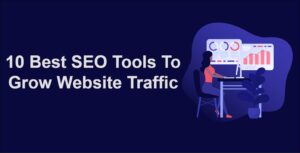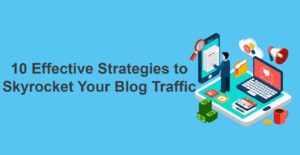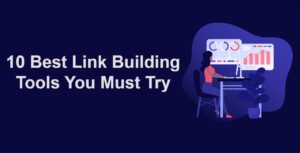In the ever-evolving world of digital marketing, staying ahead of the curve is essential to drive organic traffic and maximize your online presence. With search engine optimization (SEO) being a cornerstone of successful online marketing, mastering advanced SEO techniques can give you the edge to double your website traffic within 30 days.
Mastering advanced SEO techniques requires dedication, continuous learning, and a strategic approach. By optimizing technical aspects, creating valuable content, building quality backlinks, and staying attuned to algorithm updates, you can unlock the potential to double your website traffic in just 30 days.
SEO is a journey, and the results may take time. Stay persistent, measure your progress, and refine your strategies based on data-driven insights. Committing to excellence, you can propel your website to new heights of online success and establish a dominant presence in your industry.
In this comprehensive guide, we’ll dive into the realm of advanced SEO strategies that can help you achieve remarkable growth and outshine your competition.
What are Advanced SEO Techniques
Why Advanced SEO Techniques
Advanced SEO techniques go beyond the basics of keyword optimization and meta tags. They involve a deeper understanding of search engine algorithms, user intent, and technical aspects of website optimization.
The Importance of Advanced SEO
Advanced SEO techniques are essential for staying competitive, securing higher rankings, and adapting to evolving search engine algorithms.
They ensure optimal user experience, address new trends, and drive sustainable organic growth by outperforming rivals and adapting to changing digital landscapes.
With search engines becoming increasingly sophisticated, mastering advanced SEO techniques is crucial to maintain a competitive edge and drive substantial organic traffic to your website.
Maximizing On-Page SEO
Technical SEO Optimization
What exactly is Technical SEO
Technical SEO involves optimizing your website’s backend to improve its crawling and indexing by search engines. This includes optimizing site speed, implementing schema markup, and ensuring mobile-friendliness.
Technical SEO optimization focuses on the technical aspects of a website to improve its search engine visibility and user experience. It involves optimizing elements that affect how search engines crawl, index, and rank a site.
Enhance User Experience
A positive user experience is a crucial ranking factor. Improve your site’s navigation, layout, and readability to keep visitors engaged and encourage longer time on site.
How to enhance Your user experience for better SEO
Advanced Keyword Research
Advanced keyword research goes beyond identifying high-volume keywords. It involves analyzing long-tail keywords, semantic search, and user intent to create content that addresses specific queries.
What is Advanced Keyword Research deals with
Content Relevance and Quality
High-quality, relevant content is the cornerstone of advanced SEO. Create in-depth, comprehensive content that answers users’ questions and provides valuable insights. Strive to be the go-to resource in your industry.
The Importance of Content Relevancy
Content relevancy is crucial in SEO as it directly impacts user experience, search engine rankings, and overall online success. Relevant content meets user intent, addresses their queries, and establishes your website as a credible source of information. Here’s why content relevancy matters:
Search Engine Rankings: Search engines aim to deliver the most relevant results to users. Creating content that aligns with search intent and user expectations improves your chances of ranking higher in search results.
Reduced Bounce Rates: When users find relevant content, they’re more likely to explore other pages on your site. This reduces bounce rates, indicating to search engines that users are finding what they need.
Click-Through Rates (CTRs): Relevant content with compelling titles and descriptions can increase CTRs, as users are more likely to click on links that directly address their queries.
Long-Term Authority: Producing consistently relevant content establishes your website as an authoritative resource in your niche. This builds trust with users and search engines, leading to sustained rankings.
Keyword Optimization: Content relevancy enables strategic keyword usage, helping you rank for targeted keywords and phrases that resonate with your audience.
Featured Snippets and Rich Results: Relevant content has a better chance of being featured in rich snippets, answer boxes, and other enhanced search results, leading to higher visibility and clicks.
How Content Relevancy Improves SEO Rankings:
Better User Engagement: Relevant content captures user interest and encourages interaction, signaling to search engines that your site offers valuable information.
Natural Backlink Attraction: High-quality, relevant content is more likely to attract organic backlinks from authoritative sources, contributing to improved rankings.
Content Freshness: Updating and expanding existing content to maintain relevance signals to search engines that your site is current and valuable.
Semantic SEO
Semantic SEO involves using context and intent to understand user queries better. Optimize your content for related keywords, synonyms, and concepts to capture a wider audience and enhance your site’s relevance.
User Intent Optimization
How to Identify User Intent
Understanding user intent is crucial for advanced SEO. Tailor your content to match different stages of the buyer’s journey, from informational queries to transactional ones.
Keyword Research: Analyze the keywords users are searching for. Look for patterns in the type of keywords used, such as informational, navigational, or transactional queries.
Analyze Search Results: Examine the top search results for your target keywords. What type of content is ranking? Are they blog posts, product pages, or guides? This can give insights into what users expect.
Google Autocomplete and Related Searches: Pay attention to Google’s autocomplete suggestions and related searches. These hints provide clues about what users are searching for.
Long-Tail Keywords: Long-tail keywords often reveal specific user intent. Users searching for phrases like “best budget running shoes for beginners” have a clear intent.
Content Analysis: Study your existing content that’s ranking well. Does it match the user’s likely intent? If not, consider optimizing or creating new content that does.
User Behavior: Analyze user behavior on your site using tools like Google Analytics. Which pages are most visited? What’s the average time spent? This can indicate user preferences.
Video SEO
Leverage the popularity of video content by optimizing videos for search engines. Use descriptive titles, detailed video descriptions, and relevant tags to improve your video’s discoverability.
Build Quality Backlinks
Guest Post on Authority Sites
Guest posting on authoritative websites in your niche can help you build high-quality backlinks and establish your expertise. Focus on creating valuable and insightful guest posts.
Identify reputable websites in your niche that have a strong online presence, high domain authority, and engage with their audience. These are the sites you want to target for guest posting.
Create a well-crafted pitch that highlights your expertise, the proposed topic, and why it’s relevant to the target site’s audience. Personalize your pitch and showcase your knowledge.
Focus on delivering insightful content rather than overtly promoting your own products or services. Guest posts should benefit the audience first and foremost.
Broken Link Building Technic
Identify broken links on reputable websites and offer your own content as a replacement. This technique not only helps you earn backlinks but also benefits the website owner by fixing broken links.
Find Broken Links: Use tools like Check My Links (a Chrome extension) or website crawlers to identify broken links on your target sites’ pages. These tools highlight links that lead to non-functioning or deleted pages.
Verify Broken Links: Manually confirm that the links are indeed broken and not temporarily down. A broken link should result in a 404 error or a similar indication.
Craft Outreach Emails: Prepare personalized outreach emails to the webmasters or site owners. Mention the broken link you’ve found and offer your content as a replacement. Highlight the value your content provides.
Provide the Replacement Link: Include the URL of the broken link you found on their site and the URL of your relevant content that can serve as a replacement.
Explain the Value: Explain how your content adds value to their audience and how it’s a suitable replacement for the broken resource. Show that you’ve done your research.
Skyscraper Technique
Find popular content in your niche, create a superior version, and reach out to websites that linked to the original content. This approach can earn you high-quality backlinks from relevant sources.
Mastering Technical SEO
XML Sitemap Optimization
An XML sitemap helps search engines understand your website’s structure. Ensure it’s updated and properly formatted to aid in efficient indexing.
Canonicalization
Prevent duplicate content issues by implementing canonical tags. These tags signal to search engines the preferred version of a page when multiple versions exist.
Structured Data Markup
Implement structured data markup (schema markup) to provide additional context to search engines about your content. This can enhance your search results with rich snippets and other features.
Analyze and Adopt
Regular Performance Audits
Conduct regular audits of your website’s performance using tools like Google Search Console and Google Analytics. Identify areas for improvement and track your progress over time.
A/B Testing and Optimization
Test different elements of your website, such as headlines, CTAs, and page layouts, to determine what resonates best with your audience. Optimize based on data-driven insights.
How to perform A/B Testing
Step1: Choose a specific element you want to test, such as meta tags, headlines, content length, images, or internal linking.
Step2: Define the specific goals of the A/B test. It could be improving click-through rates, reducing bounce rates, or increasing time spent on the page.
Step3: Collect Data: Monitor relevant metrics using tools like Google Analytics, Spyfu or specialized A/B testing tools. Measure changes in user behavior, engagement, and rankings.
Step4: Analyze Results: Compare the performance of the control and variant. Did the changes improve user engagement, lower bounce rates, or higher rankings?
Staying Current with Algorithm Updates
Search engine algorithms evolve frequently. Stay informed about algorithm updates and adapt your strategies to align with the latest guidelines.





